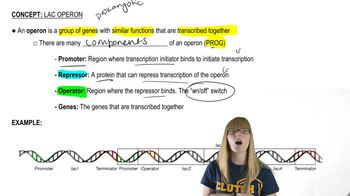Bacterial strategies to evade natural or human-imposed antibiotics are varied and include membrane-bound efflux pumps that export antibiotics from the cell. A review of efflux pumps [Grkovic, S., et al. (2002)] states that, because energy is required to drive the pumps, activating them in the absence of the antibiotic has a selective disadvantage. The review also states that a given antibiotic may play a role in the regulation of efflux by interacting with either an activator protein or a repressor protein, depending on the system involved. How might such systems be categorized in terms of negative control (inducible or repressible) or positive control (inducible or repressible)?
Table of contents
- 1. Introduction to Genetics51m
- 2. Mendel's Laws of Inheritance3h 37m
- 3. Extensions to Mendelian Inheritance2h 41m
- 4. Genetic Mapping and Linkage2h 28m
- 5. Genetics of Bacteria and Viruses1h 21m
- 6. Chromosomal Variation1h 48m
- 7. DNA and Chromosome Structure56m
- 8. DNA Replication1h 10m
- 9. Mitosis and Meiosis1h 34m
- 10. Transcription1h 0m
- 11. Translation58m
- 12. Gene Regulation in Prokaryotes1h 19m
- 13. Gene Regulation in Eukaryotes44m
- 14. Genetic Control of Development44m
- 15. Genomes and Genomics1h 50m
- 16. Transposable Elements47m
- 17. Mutation, Repair, and Recombination1h 6m
- 18. Molecular Genetic Tools19m
- 19. Cancer Genetics29m
- 20. Quantitative Genetics1h 26m
- 21. Population Genetics50m
- 22. Evolutionary Genetics29m
12. Gene Regulation in Prokaryotes
Lac Operon
Problem 19a
Textbook Question
List possible genotypes for lac operon haploids that have the following phenotypic characteristics:
The operon genes are constitutively transcribed, but the strain is unable to grow on a lactose medium. List two possible genotypes for this phenotype.
 Verified step by step guidance
Verified step by step guidance1
Understand the problem: The lac operon is a genetic system in bacteria that regulates the metabolism of lactose. The phenotype described indicates that the operon genes are constitutively transcribed (always active, regardless of lactose presence), but the strain cannot grow on lactose. This suggests a mutation affecting lactose metabolism despite constant transcription.
Recall the components of the lac operon: The lac operon includes the structural genes lacZ (encoding β-galactosidase), lacY (encoding permease), and lacA (encoding transacetylase). It is regulated by the promoter, operator, and the lacI gene (encoding the repressor). Mutations in these regions can affect transcription or lactose metabolism.
Identify mutations that cause constitutive transcription: A mutation in the operator (O^c) prevents the repressor from binding, leading to constitutive transcription. Alternatively, a mutation in the lacI gene (lacI^−) can result in a nonfunctional repressor, also causing constitutive transcription.
Determine why the strain cannot grow on lactose: For the strain to fail to grow on lactose, there must be a defect in lactose metabolism. This could be due to a mutation in the lacZ gene (lacZ^−), which prevents the production of β-galactosidase, or in the lacY gene (lacY^−), which prevents lactose transport into the cell.
Combine the mutations to propose genotypes: Two possible genotypes for this phenotype are (1) lacI^− lacZ^− or (2) O^c lacY^−. In both cases, the operon is constitutively transcribed, but the strain cannot metabolize lactose due to the lacZ^− or lacY^− mutation.
 Verified video answer for a similar problem:
Verified video answer for a similar problem:This video solution was recommended by our tutors as helpful for the problem above
Video duration:
2mPlay a video:
Was this helpful?
Key Concepts
Here are the essential concepts you must grasp in order to answer the question correctly.
Lac Operon
The lac operon is a set of genes in E. coli that are involved in the metabolism of lactose. It consists of three structural genes (lacZ, lacY, and lacA) and is regulated by the presence or absence of lactose. When lactose is present, the operon is activated, allowing the bacteria to utilize lactose as an energy source. Understanding the lac operon is crucial for analyzing how mutations can affect lactose metabolism.
Recommended video:
Guided course

Lac Operon Overview
Constitutive Expression
Constitutive expression refers to the continuous transcription of a gene regardless of environmental conditions. In the context of the lac operon, if the genes are constitutively expressed, they are produced at all times, even when lactose is not present. This can occur due to mutations in regulatory elements, leading to a phenotype where the operon is always 'on,' but the strain may still be unable to utilize lactose due to other mutations.
Recommended video:
Guided course

Penetrance and Expressivity
Genotype and Phenotype Relationship
The genotype is the genetic constitution of an organism, while the phenotype is the observable characteristics resulting from the genotype and environmental influences. In this case, the phenotypic characteristic of being unable to grow on lactose despite constitutive expression suggests specific mutations in the lac operon genes or regulatory regions. Identifying possible genotypes that correspond to this phenotype is essential for understanding the genetic basis of the observed traits.
Recommended video:
Guided course

Gamete Genotypes
Related Videos
Related Practice
Textbook Question
633
views


